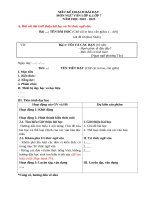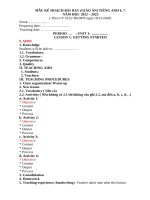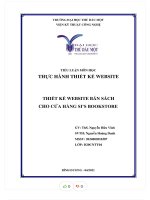Ebook Events management: A practical guide - Part 2
Bạn đang xem bản rút gọn của tài liệu. Xem và tải ngay bản đầy đủ của tài liệu tại đây (3.24 MB, 127 trang )
103
chapter eight
insurance
A ‘broker’ will arrange insurance on your behalf. It is their job to find the best deal
for you from the various appropriate underwriters in the marketplace. It is likely to
be counter productive to ask a range of brokers to find you the best quote as each
may present your case differently (bringing issues of misinterpretation) to the limited
range of underwriters available. This tends to cause the underwriter frustration and
concern.
> We recommend you select and build a relationship with an insurance broker that
you think understands the events industry and your concerns in particular. This will
ensure that you achieve the most relevant policy at the best price.
> Savings can be made when a standard policy is shaped to meet your actual needs –
for example, a policy you already have may cover elements offered in the event
policy or some of the standard policy exclusions may not apply to you.
> The more the broker (and hence the underwriter) understands about your event
the more effective and affordable your policy is likely to be. Make contact with
your broker well in advance of the event so that you can provide the kind of
information required within the relevant timeframes.
> Aim to confirm your insurance around 2–3 months before the event and no later
than a month before. A late approach tends to indicate poor management and
(potentially) increased risk.
105
chapter eight insurance
Organising the appropriate insurance for
your event is essential. Attention to detail is
of utmost importance when putting in place
the cover that is required. In taking out
insurance, the insurer/underwriter agrees to
provide security against future loss, damage
or liability in return for a non-refundable
premium paid by the event.
> Provide the broker with documents and information that communicate the
106
professional nature of your organisation and the event – this approach could well
mean savings on your premiums. Show the insurer that you understand your risk.
If you do not supply detailed information the assessor is likely to base the quote on
assumptions.
Here’s a checklist outlining the kind of information that you should expect to submit:
> An outline of the nature of the event
> Period of insurance required (event build/live event/take-down)
> Experience of the organisers (include brief CVs of the key staff)
> The number of times the event has been held and the insurance claims record. If
the event has made no insurance claims to date make sure you highlight this very
clearly
> Event capacity and audience profile
> Health and Safety policy
> Emergency arrangements
> Liaison with the local authority and any joint agency health and safety sub-groups
> Information about any staff safety training and procedures
> Production schedule
> Risk assessments
> Method statements
> Details of subcontractors and their insurance
> Details of any work to be carried out at height (i.e. above 3m)
> Site plans
> Full list of attractions
> Details about any on-site accommodation (i.e. camp sites, etc)
> Information about any specialist contractors such as pyrotechnic companies
> A schedule of the event equipment that you need to insure
> A copy of any contracts that you have with funding partners, artists, competitors,
sponsors, subcontractors, etc that feature insurance clauses (they all should). It may
be that you, as Event Manager, have to indemnify other parties against loss, damage
or liability, etc as well as yourself and the event. If the event is being funded in part
or in whole by a public sector organisation it is likely that their contract with you
will clearly state a level of public liability cover that must be in place. This figure
will then be the minimum amount of cover you require.
recommended mix of insurance cover for the event, communicate your requirements
to suitable underwriters and provide you the details of costs and cover available. The
107
When the broker has absorbed all the information they will be able to advise you on the
what the broker is earning out of the deal and the Insurance Premium Tax (IPT).
Remember to ask your broker for advice on the stability of the various underwriters
as well as the likelihood of any claims to be paid – there’s little point paying a low
premium if the insurer has a bad pay-out record.
When you have accepted a quote and received your policies, read them carefully, making
sure nothing has been omitted that you thought you were covered for. If anything
changes after taking out the policy, you must notify your insurer immediately in order
that they can update their records (this may involve a change to your premium).
Your policy is likely to include a range of cover including:
> Public Liability – this covers you against claims made by the public who attend the
event. Premiums are based on many factors including the size and profile of the
event, type of audience, etc. Levels of cover vary depending on your needs so it is
imperative that you discuss your requirements fully with a broker. The level of cover
usually required for events ranges from £2 million to £10 million.
> Employers Liability – if you have one, your existing office policy may cover you and
your staff when you are in the office, but it may not cover you when on site during
the build up/take down or the live event. It is also unlikely to cover occasional staff,
crew and volunteers who work at the event. You may therefore either need to extend
the existing cover to include additional personnel and time or take out another
policy specific to the event. The level of cover and premium often depends on the
number of staff, the payroll and duties.
Note: ensure that all freelance staff and contractors carry their own insurance and
make this a condition of your contract with them.
> Event Equipment & Property Cover – when you hire equipment for an event it is
likely that insurance is not included in the hire charge (always check this with suppliers).
Some companies offer this service based on a percentage of the hire charge, which
chapter eight insurance
quotations you receive should clearly state what is covered, the underwriter’s charge,
you can opt to take. If this service is not offered or if you choose not to take the
108
cover with them, it is imperative you insure any hired equipment from the moment
you take delivery until it is collected after the event. Also, don’t assume that any
equipment you take from your office to the event site is covered by your office
policy. You’ll need to provide a schedule of all the equipment in question and its
replacement value to your broker. It’s a good idea to start compiling this list from
the point that you start ordering hired equipment. The premium tends to be a
percentage of the total figure. Check the excess on the policy as the replacement
cost of some items covered may be less than the policy excess.
> Cancellation & Abandonment Insurance – just like it says, this covers you for
cancellation or abandonment of the event due to situations beyond your control
such as flooding, inclement weather, postponement, etc. Levels of cover will depend
on your particular requirements and the level of risk. Check the policy carefully for
exclusions. This insurance can be very costly but it’s necessary for many events,
particularly those with an entry ticket charge. If you decide not to take out this
cover, make sure you have a contingency plan in place should your event be cancelled.
You will need all or a combination of the above for event insurance purposes. In
addition, other policies may be required such as Professional Indemnity or Directors
Liability. Make sure you consider all your options carefully, check what is expected in
terms of insurance by all funding partners and seek legal advice if you are unsure.
Claims Management
Claims can be made up to three years after an incident takes place. To ensure that
you are able to successfully manage any insurance claims or defend any illegitimate
claims, make sure that you put a process in place to record all incidents:
> Ensure that you keep an incident book and that all staff are aware how incidents
should be reported and managed
> In the event of an incident, gather key information (hard evidence) such as
photographs; witness statements and contacts; details describing any equipment
involved and the activity being undertaken at the time of the incident; details of
any damage to property or persons; documentation relating to the injured person
refused; contact details for the injured person, etc
109
such as registration forms; a statement of any medical treatment offered/accepted/
might arise
> Copy any letters of claim to your broker immediately and allow them to deal with
the claim
chapter eight insurance
> Notify your insurance broker as soon as possible after an incident if you think a claim
111
chapter nine
event production:
operations, equipment,
facilities, health & safety
For further information and more detailed advice particular to your situation, we
recommend you refer to the appropriate ‘industry standard’ guides, for example:
> ‘The Event Safety Guide – A Guide to Health, Safety and Welfare at Music
and Similar Events’ (The Purple Guide), HSG195, HSE Books 1999
ISBN 0 7176 2453 6. Available from www.hsebooks.com
> ‘Guide to Safety at Sports Grounds’ (The Green Guide) by the Department
of National Heritage and the Scottish Office, the Stationery Office, 1997,
ISBN 0-11-3000-952
The above publications are considered authoritative guides. Their information is
referred to and followed by the UK events industry, local authorities and the emergency
services. The Health & Safety Executive (HSE) website is also an excellent source for
advice. The HSE is responsible for the regulation of almost all risks to health and safety
arising from work in the UK – www.hse.gov.uk
The nature and size of your event will have a direct bearing on the level of production
equipment, facilities, services, staff and time required to make it happen. Make sure
your assessment of what’s required to facilitate the production process is accurate and
build in contingencies where you can. Events with too short a production time can
attract additional and unnecessary costs and the likelihood of making mistakes or
missing out key steps in procedures that may affect health and safety will be greater.
TOP TIP
Begin to draw up a ‘production schedule’ – a detailed plan of how the
event/festival site will be prepared, operated and de-rigged. Include
actions required, contractors, timeframe, etc.
113
chapter nine event production: operations, equipment, facilities, health & safety
This chapter is intended to help you start
thinking about how to safely deliver your
event from an operational point of view.
It is not possible to comprehensively list all the production equipment, services and
114
facilities that you may require (each event is likely to have a long and very specific list
pertinent to its particular circumstances). Instead, we have provided some examples to
help you put your own checklist together.
Production Equipment – Sample Checklist
Staging and associated structures – disabled platforms, sound delay towers, etc
Lighting, audio and visual equipment
Power – generators and distribution cables
Electrical supplies
Fuel
Cable covers and ramps
Plumbing supplies
Joinery supplies
Barriers, ropes & stakes, etc – front of stage, perimeter, no-go areas,
queuing systems, etc
Portacabins, tents, marquees, etc – dressing rooms, production and site offices,
first aid points, catering, storage, baby change, etc
Ballast – for staging, tents and other structures
Temporary tracking & ground cover – trackway, blaze, hard core, sand, bark chips, etc
Transport & vehicles – forklift, cherry picker, crane, off-road vehicles, flat bed trucks,
vans, cars, etc
Fire fighting equipment – fire extinguishers, blankets, etc
Sports specific equipment – timing equipment, photo finish, hurdles, batons, etc
Refuse disposal – bins, skips, etc
Other plant hire
On site office equipment – computer, printer, admin supplies, etc
Canopies and coverings – for equipment, audience, etc in the event of
115
Seating and furniture – audience, offices, catering, dressing rooms, etc
Site decoration and dressing
Health and safety signage
Directional and information signage
Types of Facilities & Services – Sample Checklist
Sanitary facilities and associated services
Disabled facilities
Waste/rubbish removal and recycling services
First Aid & emergency services
Catering – for crew, staff, artists, competitors, guests, audiences, volunteers, etc
Phone lines
Radio communications system
Security services
Stewarding services
Information booth(s)
Lost & found
Meeting point
Drinking water
Changing facilities (sports events)
chapter nine event production: operations, equipment, facilities, health & safety
inclement weather
116
Site/Venue Layout
Site or Venue Layout is very important to the health, safety and comfort of everybody
attending and taking part in your event. A well considered layout can significantly
influence an event’s success. An event site or venue should be an effective space that
suits the type of event being staged. When beginning to plan the layout, assess all
the factors and risks associated with the following points: 1) Capacity; 2) Access,
Egress and Flow; 3) Sterile Areas; 4) Surface and Underground Conditions; 5) Existing
Site Features; 6) Placement of Equipment and Services; 7) Sanitary Facilities; 8) Local
Residents; 9) Signage; 10) Facilities for People with Disabilities; 11) Litter and Waste.
As you do this, you will be able to plot the various elements of the event to achieve
maximum site efficiency and safety.
1) Capacity
The capacity of your site/venue is calculated based on the available audience space,
the number of emergency exits (see Access, Egress & Flow) and the risk assessment for
the venue and the event. Site Layout is therefore particularly important if you need to
maximise the audience potential. Keep in mind:
> For outdoor events where a standing crowd gathers in a defined space to watch the
entertainment (such as at a street theatre or a music event) the general acceptance
for a clear, flat, open space with a reasonable view of the performance is 2 people
per 1m2. However the figure should not be applied to all of the available space.
> Not all of the available space for the audience will have a clear view of the
entertainment. In such instances a lesser figure should be applied or the area
should be taken out of the equation altogether.
> Existing site features such as hills, trees and site line obstructions will further reduce
the capacity.
> Other areas that may be in and around the audience space such as front of house
areas, media stands, camera positions, judges boxes, sound delay towers, water
towers, disabled platforms, etc will further reduce the capacity.
number and type of rides and the available space between the rides.
117
> Types of entertainment such as funfairs will have different calculations based on the
may be actual seats or it could be areas where people can sit on the ground. If the
venue is outdoors you may or may not have covered areas to sit or stand if the weather
is inclement. Each of these points will influence the final capacity of the event.
Remember to also take into account any potential ‘pinch points’ around the venue.
> If the site/venue area is extensive, consider the viability of placing screens around
the site to show the main entertainment. These may be helpful with increasing
capacity potential while reducing the possibility of overcrowding or surging.
> Remember to recalculate the capacity if the site layout changes or if structures are
added, removed, etc.
> As you can see, the calculation and issue of capacity can be tricky and it may be
helpful to involve an experienced risk assessor who will provide advice and a
maximum capacity figure after consideration of all the facts.
2) Access, Egress & Flow
The access, egress and flow of the audience, staff, equipment and the entertainment
require careful consideration. A range of issues are required to be taken into account.
These include:
> The venue may have existing or natural points of access/egress. If you have chosen
an existing indoor venue, then its access and egress points (which will have helped
determine the capacity) are likely to be fixed. However, if you are utilising an openplan outdoor site you will have to determine where the best possible access and egress
points should be for the audience, staff and equipment. The exit requirements depend
on capacity and the acceptable time taken to exit the venue. Seek advice from the
local authority and the Fire Brigade when calculating number and width of exits.
> Spectator flows at sports events, i.e. access and egress during sessions, should be
considered.
chapter nine event production: operations, equipment, facilities, health & safety
> Your venue may be seated, standing or a combination of both. The seating available
to enter and exit the venue.
> Do not mix pedestrian and vehicular access/egress if at all possible. Similarly, try to
keep public, staff and performer/participant access/egress separate from each other.
> Ensure all access points have suitable gathering/queuing spaces for the audience
expected and all egress points have safe exit potential.
> Individual or specially created access for the disabled may be required.
> Consideration must also be given to the emergency services. It is likely you will
require the presence of first aid facilities at the event but in the event of a more
serious incident arising, e.g. someone requires hospital attention or a fire tender
needs access, clear access into the site, passage around the site and egress from the
site is necessary. If appropriate, representatives from the emergency services should
be able to advise on this point and may recommend sterile access routes or pathways
for their use.
> To avoid the audience making their own paths, create clearly defined routes
around the site that are wide enough to accommodate the amount of footfall that
is anticipated.
> Ensure there is enough space for people to gather or queue at concession or
entertainment areas without impeding the paths or access/egress routes.
> Avoid building dead ends into the layout at all costs as these could be detrimental
to health and safety.
> The siting of entertainment should encourage a steady movement of the audience
around the event site/venue. In other words, if there is multiple entertainment on
offer, it should not be concentrated in the one area. This will help minimise the risk
of ‘hot spots’ and bottlenecks building up. Avoid a haphazard or cluttered layout as
this can impede flow.
chapter nine event production: operations, equipment, facilities, health & safety
can fit through the access/egress and there is suitable turning space for large vehicles
119
> You must also check that any large equipment that is being brought to the event
3) Sterile Areas
120
Depending on the size and nature of the event, it may be necessary to build in areas to
the site that are sterile – in other words, areas that the public should not gain general
access. Areas such as a Rendezvous Point (for emergency services to use in the event of
a major incident) or a fireworks fall-out zone require careful consideration of their
placement, size and barrier/security protection system. Remember that the area chosen
must be suitable for the function it will perform.
4) Surface and Underground Conditions
If the event is taking place outdoors, a thorough assessment of the existing and
anticipated surface conditions is necessary. Bear in mind the following points:
> Ensure that the ground can accommodate what you intend to place on it
(size, type and weight).
> Assess the impact that adverse weather conditions may have on the ground. Pay
particular attention to the risk of flooding as this can cause the most damage to
equipment and is a likely cause of cancellation.
> If you are anticipating adverse conditions, ensure you have contingencies in place
to deal with all possibilities, e.g. water pump for flooding, temporary tracking or
bark chippings for muddy areas, grit for frost paths/roads, etc.
> If appropriate, ask the land-owner or local authority for an underground utilities
assessment to advise you about any underground cables, wires or pipes that could
potentially be damaged by heavy equipment or penetration of the ground.
> The type of event and the chosen location may necessitate bringing in or creating
temporary surface conditions such as tracking for transport or emergency services
or to protect the ground below. Check that the ground beneath is suitable for the
covering to ensure this doesn’t become a hazard in itself.
> Ensure that any damage anticipated can be put right or reinstated as failure to do
this could incur heavy financial penalties.
5) Existing Site Features
If your event is being held outdoors, you may have to accommodate existing site
features in the site layout. Whenever possible, use these to your advantage but make
sure that your risk assessment of these features identifies all possible risks they may
pose and put in place the necessary control measures to minimise such risks. Site
features may include: hills, gullies, open water, trees, overhead cables, public art or
monuments, etc.
6) Placement of Equipment and Services
Different factors will influence where you finally position equipment and services but
keep in mind the following:
> Place equipment and plant as close as possible to where it is needed without impeding
audience view or affecting audience enjoyment. This will also help reduce the amount
of cabling required.
> Ensure that any equipment that has to be placed in the vicinity of an audience is
secured and can cause no harm. Place it in an area that is accessible should it require
attention during the event.
> Any disabled viewing platforms should be positioned to ensure maximum visibility
without negatively affecting audience capacity and sight lines.
> If there are simultaneous entertainments, position them to ensure there is no clash
of sound or audience.
> Make sure all welfare services are in a convenient and visible location and are well
sign posted. Similarly with rubbish bins, place them in visible locations and particularly
around catering areas.
chapter nine event production: operations, equipment, facilities, health & safety
being used.
121
> If the event is indoors, check that the floor can take the weight of the equipment
7) Sanitary Facilities
122
The calculation of the level of sanitary facilities required at events is based on a range of
factors including the audience capacity, audience profile, location, duration and existing
facilities. General guides exist but it is best to seek the advice of an experienced contractor
and the local authority (Environmental Health) to ensure your estimate is neither too
high nor too low. When planning these facilities, keep in mind the following points:
> Toilet ‘clusters’ are best placed in various locations throughout an outdoor site.
They should be clearly signposted, adequately lit and positioned away from food
preparation areas. These facilities should be cleaned and re-stocked regularly
throughout the day and, depending on the length of the event and the type of
unit used, they may require to be emptied during the course of the event. If this
is the case, ensure that the siting of them allows for vehicle access.
> Everyone using the toilet should be able to wash their hands with warm water
(ideally) and soap. Again, these areas should be kept clean and restocked regularly.
If wash facilities have to be separate from the toilets, ensure that you leave enough
room when planning the site and ensure that appropriate drainage is possible to
avoid unsanitary or flooded conditions. Again, your contractor and local authority
can advise on this matter.
> Ensure there are sanitary facilities in the vicinity of first aid and baby change areas
and don’t forget about the artists, participants, employees and concessionaires that
will require appropriate facilities too. If there are camping opportunities at the event,
you will also need to supply washing and toilet facilities for this group.
> If you have an area set aside for people with disabilities, appropriate sanitary facilities
should be placed in the vicinity and clearly signposted.
8) Local Residents (Commercial and Domestic)
When planning the site layout, keep in mind local residents (if there are any) and bear
in mind the following:
> Make sure event elements such as access/egress points, transport drop off points,
parking arrangements, sterile areas, etc do not impede entry to or encroach on
their property.
not hamper their day-to-day business.
123
> If the residents are commercial, ensure the site layout and nature of the event do
the residents.
> You may need to hold a special meeting with the local residents to familiarise them
with what will be happening on their doorstep and provide reassurance about how
you will minimise any concerns they may have in connection with the event.
> Be prepared to make special arrangements for those who are particularly negatively
affected and ensure all residents are informed of what is happening either through
a special meeting and/or a leaflet or letter drop to their residence.
9) Signage
Regardless of how well-considered the layout is, if you do not have the appropriate
signage to direct people around the site/venue (or to follow in the event of an incident)
the space could be rendered ineffective, crowd management issues may result and
health and safety compromised. For further information on safety signage legislation see
HSE’s The Health & Safety (Safety Signs and Signals) Regulations 1996 at www.hse.gov.uk
You may require a range of signage to perform various functions:
> Directional signage – e.g. to direct people to the nearest exit, toilet, bar, etc.
> Information signage – e.g. to tell people where they are in the venue/on the site,
to show people where facilities are on the site, the running order of the
entertainment, etc.
> Safety signage – e.g. showing the location of emergency exits, fire fighting
equipment, danger zones, etc.
> Welfare signage – e.g. meeting point, baby change, lost persons, drinking water,
first aid, etc.
chapter nine event production: operations, equipment, facilities, health & safety
> If the event is using sound systems, where possible point the sound away from
> The location and timing of the event will dictate whether you need to light some of
125
Points to consider are:
> All signage should be of the correct dimensions and design and placed
appropriately around the site/venue so as to be clearly visible.
> If your event is outdoors, ensure all signage is waterproof, wind permeable
(as appropriate) and fastened securely.
> Make sure arrows are pointing in the right direction.
> Place sponsorship banners/signage in visible positions (agreed in advance with your
sponsor – see Chapter 5) but ensure they do not impede audience sightlines or flow.
> Remember signage will be required for all areas of the event including back stage,
production areas, media locations and dressing rooms as well as front of house
where the audience is.
> Remember to think about how the audience will find the event. Ensure the event
site is well signposted at access points coming into the town and at key junctions.
Organising AA signs can be an inexpensive way to achieve this www.theaa.com
> It’s worthwhile creating a ‘signage plan’ to address how, where, when and who will
erect the required signs and banners – always ensure the appropriate permissions
have been sought.
10) Facilities for People with Disabilities
An inclusive approach is required for all aspects of event planning. People with disabilities
have the right to equal treatment and should not be discriminated against. At the
planning stage ask yourself if you need to implement special measures in order to make
the event accessible to people with mobility problems, sight or hearing impairments or
other special needs. You must make the appropriate provision for suitable access to and
egress from the event as well as goods, services and facilities for all. Provision may include:
chapter nine event production: operations, equipment, facilities, health & safety
the signage (such as exit signage in marquees, indoor venues, night time events, etc).
> Widened access/egress doors and routes
126
> Ramps
> Handrails
> Lifts
> Sanitary Facilities
> Lowered surfaces – for instance at food outlets and info points
> Floor surfaces & ground coverings
> Parking
> Transport to and around the event
> Seating
> Viewing areas
> Signage
> Hearing systems
> Staff or stewarding support
> Light and sound levels
> Accommodation
> Free access for carers
Remember to consider people with disabilities when preparing emergency
and evacuation plans. Further information on this topic can be gained from
www.direct.gov.uk/disability
11) Litter & Waste
Events can create a tremendous amount of litter and waste that has to be collected,
disposed of and recycled as appropriate. A build up of waste can be harmful to the
health and safety of all those involved or affected by the event and the environment.
It is therefore important to prepare for and stay in control of this issue. As event
manager you must ensure that rubbish and waste is disposed of in the correct manner.
If you are using a waste management contractor, make sure they are reputable and
can supply you with method statements.
Create a Waste Management Plan in advance of the event. This will help identify areas
of concern and how the issue will be addressed. Your plan should consider the following:
> The event type, audience profile and capacity.
public, artists, pyrotechnics, toilets & showers, medical areas, etc.
> Waste types, e.g. food remnants/paper/plastic at catering concessions, wood/metal/
127
> Waste generators, e.g. production, administration, catering, bar operators, general
> Waste locations, e.g. skip in production area, bottle bank for bar use.
> Recycling opportunities (recycle and reuse whenever possible).
> Waste management activity, i.e. what is going to be uplifted, when will this happen
and by whom (before, during and after the event).
> Waste management promotion, i.e. how will you encourage others to minimise
waste and dispose of it properly.
TOP TIP
Be aware of any specific restrictions that your site/venue may pose as
these will have an impact on the planning process.
Site/Venue Plans
Site (or venue) plans or maps are necessary for any event. They serve as a tool to help
calculate the capacity and maximise the effectiveness of the site/venue in the planning
stages. They also act as a communication tool between everyone involved during build-up
and the live event. A copy of the plan(s) should be included in the Event Manual (see
Chapter 10) and larger versions should be given to all the managers, appropriate
contractors and agencies working at the event for quick and easy reference.
If you are using an existing venue, it is likely a floor plan will already be in existence
which you can get a hold of and add your information to. If you are working outdoors,
it is likely you may have to start your plan from scratch. Ask the land owner or the
local authority if they can provide you with a blank map of the area, showing existing
site features such as hills, walls, trees, paths, roads, etc. You can then start to add in
your particular information.
chapter nine event production: operations, equipment, facilities, health & safety
paper/fuel at production area, drink cartons/food/paper flyers/etc front of house.
> Waste receptacles and requirement, e.g. skips, plastic bins, bottle banks, etc.







